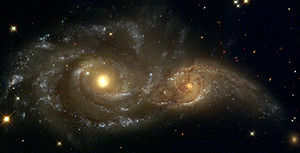- NGC 2207 and IC 2163
-
NGC 2207 / IC 2163 
A Hubble Space Telescope (HST) image of NGC 2207 and IC 2163.
Credit: HST/NASA/ESA.Observation data (J2000 epoch) Constellation Canis Major Right ascension 06h 16m 22.0s / 06h 16m 28.0s[1] Declination -21° 22′ 22″ / -21° 22′ 33″[1] Redshift 2741 ± 15 / 2765 ± 20 km/s[1] Distance 81 ± 39 Mly
(24.9 ± 12 Mpc)[2]Type SAB(rs)bc pec / SB(rs)c pec[1] Apparent dimensions (V) 4′.3 × 2′.8 / 3′.0 × 1′.2[1] Apparent magnitude (V) 12.2 / 11.6[1] Notable features colliding galaxies Other designations RR59 132,[citation needed] PGC 18749 / 18751[1] See also: Galaxy, List of galaxies NGC 2207 and IC 2163 are a pair of colliding spiral galaxies about 80 million light-years away[2] in the constellation Canis Major. Both galaxies were discovered by John Herschel in 1835. So far three supernovae have been observed in NGC 2207 (SN 1975A, SN 1999ec and SN 2003H). NGC 2207 is in the process of tidal stripping IC 2163.
In November 1999, the Hubble Space Telescope took a look at these galaxies.
In April 2006, the Spitzer Space Telescope also took a look at these galaxies (Picture seen below).
Merging galaxies
NGC 2207 is in the process of colliding and merging with IC 2163. But unlike the Antennae or the Mice Galaxies, they are still two separate spiral galaxies. They are only in the first step of colliding and merging. Soon they will collide, probably looking a bit more like the Mice Galaxies. In about a billion years time they are expected to merge and become an elliptical galaxy.
See also
References
- ^ a b c d e f g "NASA/IPAC Extragalactic Database". Results for NGC 2207 / IC 2163. http://nedwww.ipac.caltech.edu/. Retrieved 2006-11-25.
- ^ a b "Distance Results for NGC 2207". NASA/IPAC Extragalactic Database. http://nedwww.ipac.caltech.edu/cgi-bin/nDistance?name=NGC+2207. Retrieved 2010-05-22.
External links
Categories:- Intermediate spiral galaxies
- Barred spiral galaxies
- Peculiar galaxies
- Interacting galaxies
- Canis Major constellation
- NGC objects
- IC objects
- PGC objects
- Supernovae
Wikimedia Foundation. 2010.


